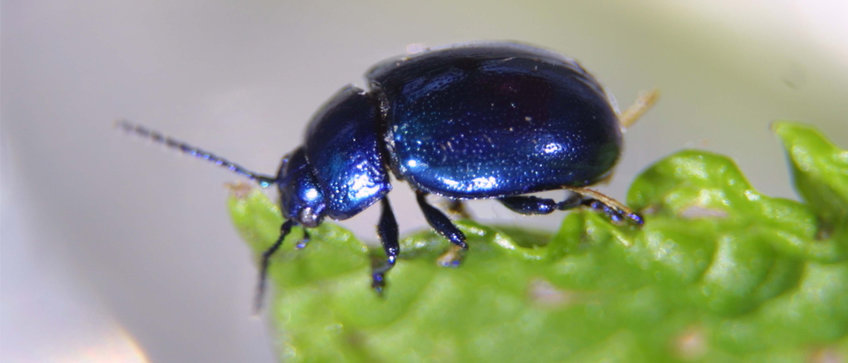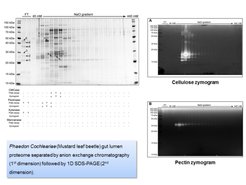
Molecular Biology of the Insect Digestive System
Our research is centered on the digestive system of insects. We are mainly focusing on phytophagous insects from the orders Lepidoptera (butterflies and moths) and Coleoptera (beetles). We are currently developing the following projects:
Proteomics of the insect midgut
Although genomic approaches based on sequencing of cDNA libraries and microarrays can provide information on the identity and abundance of mRNAs produced in the midgut cells, they provide no information on the spatial distribution of proteins in the different compartments of the midgut, and offer no insights into their temporal dynamics afterward, which are exclusively determined by post-translational processes. We are applying proteomic techniques to map the midgut proteome in detail to get more insights on the likely function of this key tissue in insect larvae. We also couple our proteomic analyses to enzyme assays, such as zymograms and thin layer chromatography, to focus on activities of interest.

Evolution of plant cell wall degrading enzymes (PCWDEs) in herbivorous beetles
Although the presence of plant cell wall degrading enzymes in herbivorous beetles has been known since the late 1990’s, we recently discovered, by using deep sequencing of beetle midgut transcriptomes, that these enzymes are part of multigene families of moderate size and seem to be restricted to species of the two superfamilies Chrysomeloidea (longhorn beetles and leaf beetles) and Curculionoidea (weevils, bark beetles). Sequences encoding these beetle-derived PCWDEs strikingly resemble those of saprophytic and phytopathogenic microorganisms and, together with the fact that PCWDEs are patchy distributed in animals, raise questions about their origin (e.g. insect-derived or microorganism-derived?). Our primary goal resides in deciphering the evolutionary origins of PCWDEs in these beetles and characterizing their biological function (i.e. Do they still possess the ability to hydrolyze plant cell wall polysaccharides or did they evolve new functions?). Our primary analyses indicate that most of these genes have been originally acquired by beetles through several horizontal gene transfer events. We demonstrate that these gene families evolved by subfunctionalization and neofunctionalization in beetles. In the context of plant-insect interactions, we are also interested in determining if plants have evolved defenses, such as inhibitors, targeting insect PCWDEs.
Dr. Roy Kirsch, postdoc, Pauline Sell, doctoral researcher and Wiebke Häger, doctoral researcher
Cooperations
- Molecular dissection of nuptial feeding in the decorated cricket Gryllodes sigillatus
Collaborators: John Hunt and Richard H. ffrench-Constant, University of Exeter, UK and Scott K. Sakaluk, Illinois State University, USA
- Genetic basis of the resistance to Bacillus thuringiensis Cry3A toxin in Chrysomela tremula
Collaborators: David Pauron, INRA Sophia Antipolis, France, and Sylvie Augustin, INRA Orléans, France
